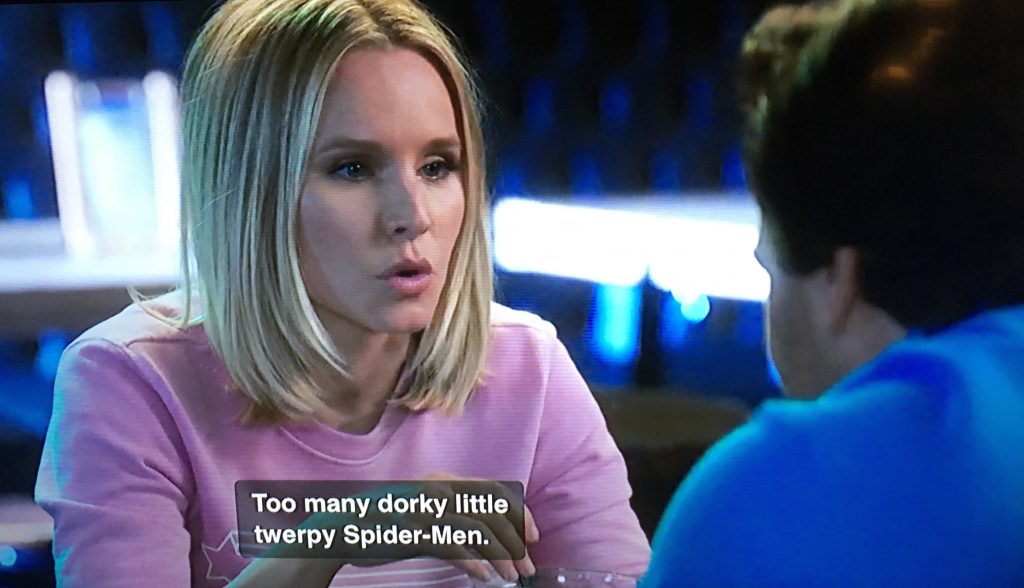Back on Earth…
Following Avengers: Age of Ultron (2015), new solo heroes were introduced to the Marvel Cinematic Universe that have had a drastic effect on the universe at large.
Ant-Man: Ant-Man (2015), which premiered only a couple months after Ultron, introduces us to Scott Lang/Ant-Man. Scott is in jail following a Robin Hood-esque stunt in which he electronically stole huge amounts of money and returned it to the people it was “legally” taken from. Upon his release he struggles to find work to pay child support and see his daughter. Hank Pym/the original Ant-Man manages to trick Scott into stealing the Ant-Man suit, which enables the wearer to become smaller/bigger. Hank had previously worked with SHIELD before founding Pym Technologies and now finds himself being ousted. Together with Hank’s daughter, Hope van Dyne (later, the Wasp), the three of them work together to steal Hank’s technology and stop Darren Cross/Yellowjacket.
Later, Scott fights for Captain America’s team in Captain America: Civil War (2016), playing an integral role in Steve Rogers/Captain America and Bucky Barnes/Winter Soldier’s escape. To avoid jail time, he takes a deal that has him under house arrest for two years.
While Scott does not make an appearance in Avengers: Infinity War (2018), the events of his second solo outing appear to be incredibly relevant to the forthcoming Avengers: Endgame. In Ant-Man and the Wasp (2018), Scott is nearing the end of his sentence while Hank and Hope are working to build a tunnel to the Quantum Realm to rescue Hank’s wife and Hope’s mother, Janet van Dyne, the original Wasp. Their experimentation leads to the realization that Scott and Janet became quantumly entangled with Janet during the climax of Ant-Man. Hank and Hope then kidnap Scott, leaving a decoy behind for the FBI as Scott nears his release day.
Hank, Hope, and Scott find opposition to their plans in the forms of Sonny Burch, a black market dealer hoping to profit off Hank’s inventions, and Ava Starr/Ghost, who seeks the Quantum Tunnel to end her own suffering caused in part by Hank Pym. In the end, Sonny and his gang are arrested, Janet is recovered and helps heal Ava, and Scott is released.
What appears to be the key element for Endgame is the Quantum Realm itself, which has the potential to enable time travel. From what we’ve seen, both from Ant-Man and the Wasp and from the Endgame trailers is that Scott loses everyone important to him in Thanos’s snap, but will find his way to the Avengers to help fix what happened in Infinity War.
Doctor Strange: Although referenced by name in Captain America: The Winter Soldier (2014), Doctor Stephen Strange doesn’t make an appearance in the Marvel Cinematic Universe until his solo film in 2016. In the film, after losing the use of his hands, surgeon Stephen Strange turns to mysticism to get his hands back. Instead, he finds himself in an inter-dimensional battle for Earth, in which he uses the Time Stone to defeat his enemy. He becomes a Master of the Mystic Arts and the keeper of the New York Sanctum, which helps protect the world from forces outside their dimension.
Stephen makes his next appearance in Thor: Ragnarok (2017) in which he kidnaps Loki when he realizes he’s on Earth. As Earth’s primary protector from things outside the Avengers purview, he explains to Thor that he really just wants Loki off-planet as soon as possible before he can cause any new trouble. He does help the Odinson brothers find their father, however, whom he had helped previously.
Doctor Strange plays a huge role in the events of Infinity War. As the protector of the Time Stone, he is a direct adversary for Thanos. After arriving on Titan with Tony Stark/Iron Man and Peter Parker/Spider-Man, he looks into possible futures to realize that there’s only one in which they win. Before he disintegrates he tells Tony, “We’re in the endgame now,” implying that he knew what would come next and how it would be reversed.
Spider-Man: Following his introduction in Civil War, Peter Parker/Spider-Man becomes something of a son to Tony Star/Iron Man. In Spider-Man: Homecoming (2017), Peter establishes himself as a “friendly neighborhood Spider-Man”, realizing the he is not ready for the kind of responsibility that comes with being an Avenger (and an adult).
In Infinity War, Peter travels to Titan with Tony and Stephen. As in the comics, he (and the others) almost succeed in removing the Infinity Gauntlet from Thanos. His disintegration is heartbreaking for both Tony and the audience.
Black Panther: T’Challa/Black Panther’s first movie came out only months before Infinity War, but actually only takes place a few weeks after Civil War. In Black Panther (2018), T’Challa becomes king of Wakanda and battles his long-lost cousin, N’Jadaka/Erik “Killmonger” Stevens for the title. His actions during the film unite all of Wakanda’s tribes and opens up Wakanda and her technology to the outside world.
T’Challa and the Wakandan people play a large role in protecting the Earth from Thanos. While T’Challa’s endlessly brilliant sister, Shuri, works to remove the Mind Stone from Vision so it can be destroyed, the rest of Wakanda battles Thanos’s forces. As the most technologically advanced country on the planet, they are the best equipped for such a task, however, many lose their lives during Thanos’s snap, including T’Challa himself.
Okoye, the leader of the Dora Milaje, Wakanda’s elite female warriors is featured in one of the Endgame posters, which establish who did and didn’t survive the snap. While she hasn’t been an obvious part of the trailers, it’s fair to assume that she will play a big part. There is also talk that she may play a role in the potential/rumored A-Force movie, which will have an all-female Avengers team.
Nick Fury: Although he was the director of SHIELD for years, in 1995, Nick Fury was still someone else’s subordinate and new to the amount of weird in the world. It’s also when he meets Carol Danvers/Captain Marvel. It’s after meeting her that he gets the idea for the Avengers Initiative and he is the one to initially bring them together. In the present, Fury hasn’t been seen since he came to the rescue in Ultron, providing lifeboats for the Sokovians. At the end of Infinity War, however, he manages to use his modified pager (a gift from Carol at the end of Captain Marvel (2019)), to send a message before disintegrating. We don’t know what Carol has been up to since we saw her leave Earth, but it’s clear that she will play a role in Endgame, thanks to Fury’s quick thinking.

